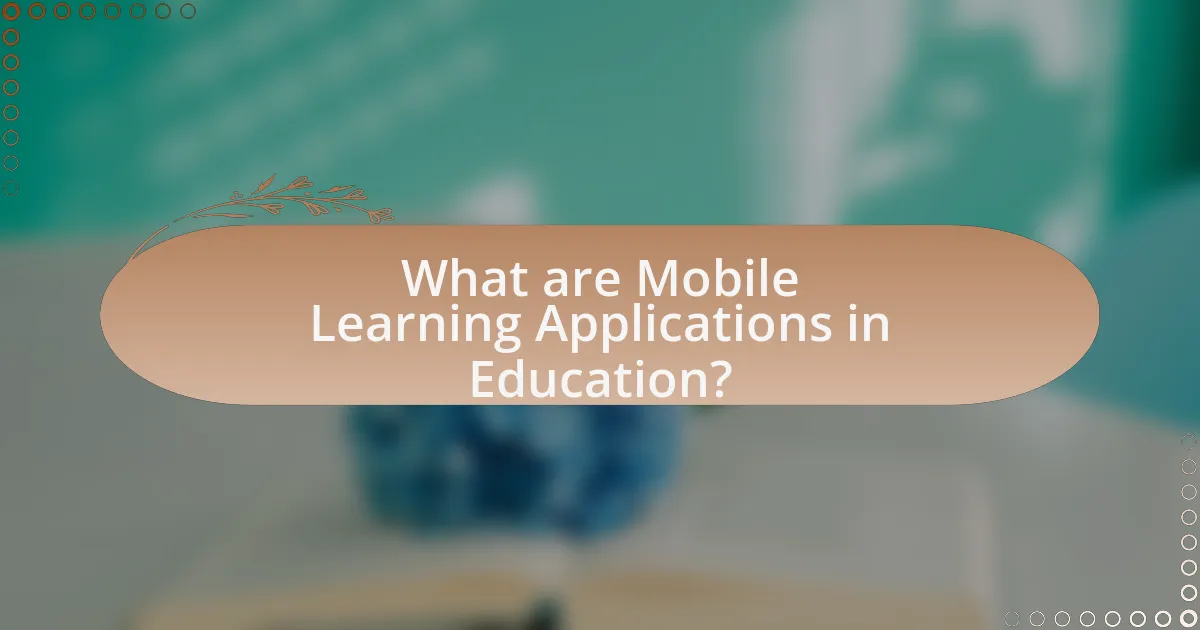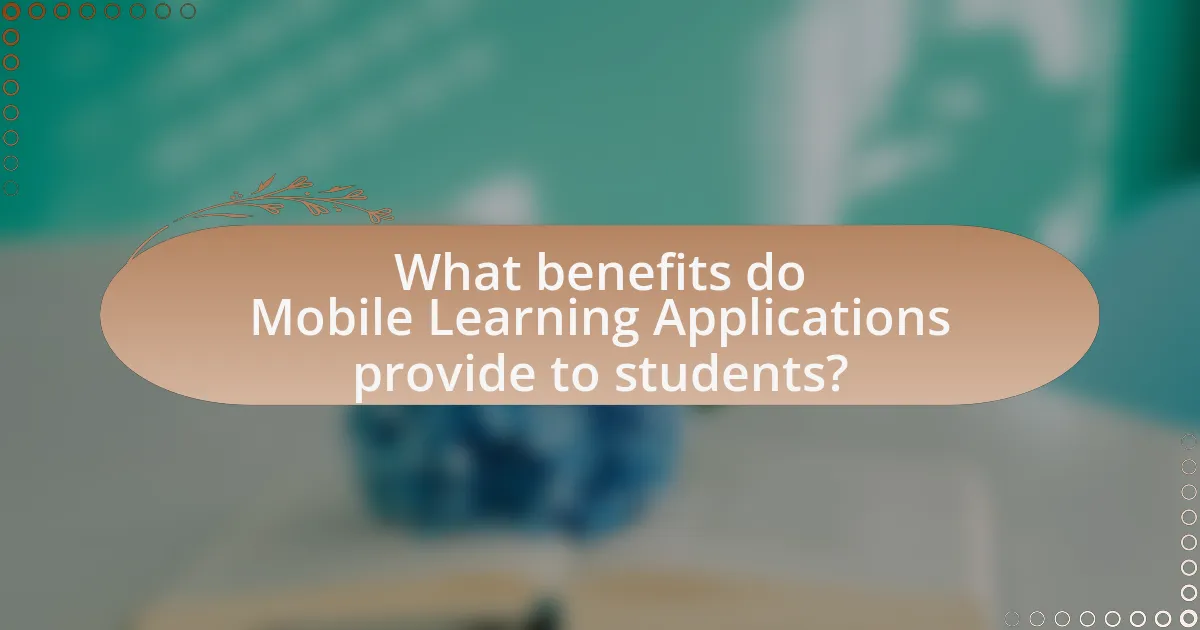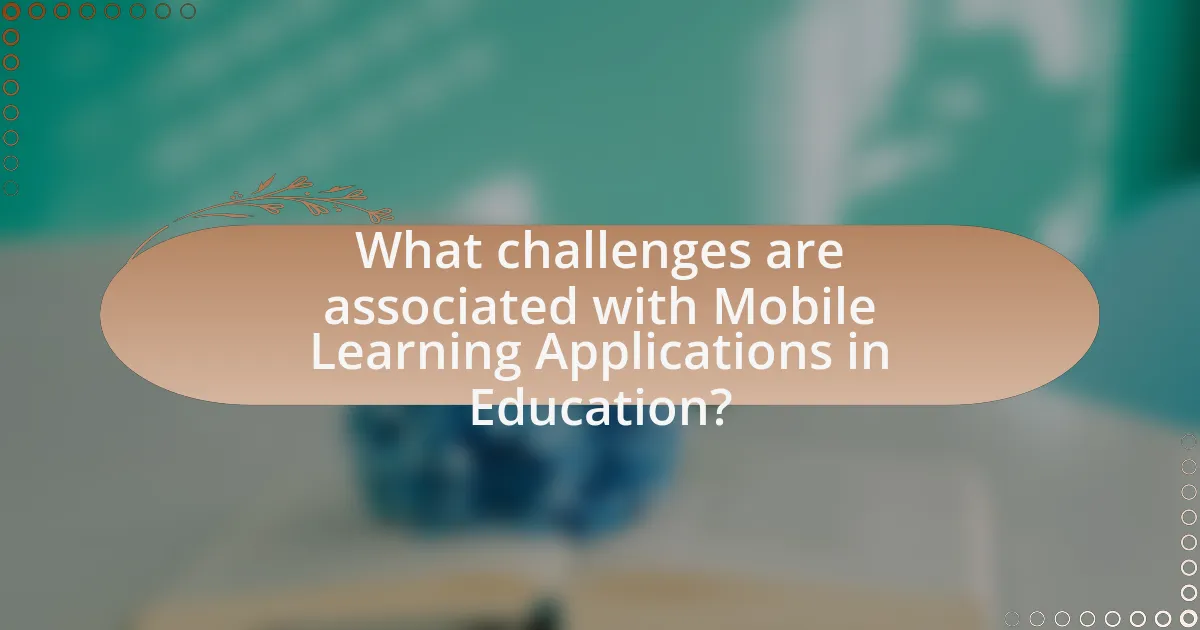Mobile learning applications are software tools designed to enhance educational experiences through mobile devices, enabling students to access content and engage in interactive learning anytime and anywhere. These applications improve student engagement and learning outcomes by offering personalized experiences, immediate feedback, and features such as quizzes and multimedia resources. Key technologies supporting mobile learning include mobile devices, cloud computing, and learning management systems, which collectively enhance accessibility and flexibility in education. The article explores the benefits of mobile learning applications, their impact on diverse learning styles, and the challenges faced in their implementation, while also discussing future trends and the role of artificial intelligence in shaping these educational tools.

What are Mobile Learning Applications in Education?
Mobile learning applications in education are software tools designed to facilitate learning through mobile devices such as smartphones and tablets. These applications enable students to access educational content, engage in interactive learning experiences, and communicate with peers and instructors anytime and anywhere. According to a study published in the Journal of Educational Technology & Society, mobile learning applications enhance student engagement and improve learning outcomes by providing personalized learning experiences and immediate feedback.
How do Mobile Learning Applications function in educational settings?
Mobile learning applications function in educational settings by providing accessible, interactive, and personalized learning experiences through mobile devices. These applications enable students to engage with educational content anytime and anywhere, facilitating self-paced learning and immediate feedback. Research indicates that mobile learning can enhance student motivation and retention, with a study by the International Journal of Mobile and Blended Learning showing that 85% of students reported improved learning outcomes when using mobile applications. Additionally, mobile learning applications often incorporate features such as quizzes, multimedia resources, and social interaction, which further support collaborative learning and knowledge retention.
What technologies enable Mobile Learning Applications?
Mobile learning applications are enabled by several key technologies, including mobile devices, cloud computing, and learning management systems (LMS). Mobile devices, such as smartphones and tablets, provide the hardware necessary for users to access educational content anytime and anywhere. Cloud computing facilitates the storage and retrieval of vast amounts of educational resources, allowing for seamless updates and accessibility across devices. Learning management systems integrate these technologies by providing a platform for course delivery, tracking learner progress, and enabling interactive features such as quizzes and forums. These technologies collectively enhance the flexibility and effectiveness of mobile learning, making education more accessible and engaging.
How do users interact with Mobile Learning Applications?
Users interact with Mobile Learning Applications primarily through touch-based navigation, engaging with content via taps, swipes, and gestures. This interaction allows users to access educational materials, complete quizzes, and participate in discussions seamlessly. According to a study by the International Journal of Mobile and Blended Learning, 85% of users reported that intuitive interfaces and interactive features significantly enhanced their learning experience. Additionally, features like push notifications and gamification elements encourage regular engagement, making learning more dynamic and effective.
What are the key features of Mobile Learning Applications?
Mobile learning applications are characterized by several key features that enhance educational experiences. These features include accessibility, allowing learners to access content anytime and anywhere; interactivity, which engages users through quizzes and discussions; personalization, enabling tailored learning paths based on individual needs; offline functionality, permitting use without internet connectivity; and multimedia support, incorporating videos, audio, and graphics to enrich learning. Research indicates that these features significantly improve learner engagement and retention, as evidenced by a study published in the Journal of Educational Technology & Society, which found that mobile learning applications can increase student motivation and learning outcomes.
How do personalization and adaptability enhance learning experiences?
Personalization and adaptability significantly enhance learning experiences by tailoring educational content to individual learner needs and preferences. Personalized learning allows students to engage with material that aligns with their interests, learning styles, and pace, leading to increased motivation and retention. Adaptability ensures that learning pathways can shift in response to a learner’s progress, providing timely support or challenges as needed. Research indicates that personalized learning can improve student outcomes; for example, a study by the Bill & Melinda Gates Foundation found that personalized learning approaches can lead to a 20% increase in student achievement compared to traditional methods. This evidence underscores the effectiveness of personalization and adaptability in creating more effective and engaging educational experiences.
What role does gamification play in Mobile Learning Applications?
Gamification enhances engagement and motivation in mobile learning applications by incorporating game-like elements such as points, badges, and leaderboards. These features encourage learners to participate actively, fostering a sense of achievement and competition. Research indicates that gamification can lead to a 60% increase in user engagement and a 30% improvement in learning outcomes, as evidenced by a study published in the Journal of Educational Technology & Society, which highlights the positive impact of gamified elements on learner retention and satisfaction.

What benefits do Mobile Learning Applications provide to students?
Mobile learning applications provide students with enhanced accessibility to educational resources, allowing them to learn anytime and anywhere. This flexibility supports diverse learning styles and schedules, enabling personalized education. Research indicates that mobile learning can improve student engagement and retention rates; for instance, a study by the University of California found that mobile learning increased student participation by 30%. Additionally, these applications often incorporate interactive elements, such as quizzes and multimedia content, which further enhance the learning experience and facilitate better understanding of complex subjects.
How do Mobile Learning Applications improve accessibility to education?
Mobile learning applications improve accessibility to education by providing flexible, on-demand access to learning resources anytime and anywhere. These applications enable learners to engage with educational content through smartphones and tablets, breaking geographical barriers and allowing individuals in remote or underserved areas to access quality education. According to a report by the International Telecommunication Union, mobile broadband subscriptions reached 5.3 billion globally in 2020, highlighting the widespread availability of mobile devices that facilitate this access. Furthermore, mobile learning applications often include features such as offline access, personalized learning paths, and interactive content, which cater to diverse learning needs and preferences, thereby enhancing educational equity.
What impact do Mobile Learning Applications have on learning outcomes?
Mobile Learning Applications significantly enhance learning outcomes by providing flexible, accessible, and personalized educational experiences. Research indicates that students using mobile learning applications demonstrate improved engagement and retention rates, with a study by the University of California showing a 20% increase in knowledge retention compared to traditional learning methods. Additionally, mobile applications facilitate immediate feedback and adaptive learning paths, which cater to individual learning styles and paces, further contributing to better academic performance.
How do Mobile Learning Applications support diverse learning styles?
Mobile learning applications support diverse learning styles by offering personalized content delivery, interactive features, and varied multimedia resources. These applications cater to visual, auditory, and kinesthetic learners by incorporating videos, podcasts, and hands-on activities, respectively. For instance, a study by Ally (2004) in “Mobile Learning: Transforming the Delivery of Education and Training” highlights that mobile learning can adapt to individual preferences, enhancing engagement and retention. Furthermore, the flexibility of mobile learning allows learners to access materials anytime and anywhere, accommodating different paces and schedules, which is crucial for diverse learning needs.
What advantages do Mobile Learning Applications offer to educators?
Mobile learning applications offer educators enhanced accessibility, allowing them to deliver content anytime and anywhere. This flexibility supports diverse learning environments and accommodates various teaching styles. Additionally, these applications facilitate personalized learning experiences, enabling educators to tailor content to individual student needs. Research indicates that mobile learning can increase student engagement and motivation, as evidenced by a study published in the Journal of Educational Technology & Society, which found that 85% of students reported improved learning outcomes when using mobile applications. Furthermore, mobile learning applications often include analytics tools that help educators track student progress and performance, providing valuable insights for instructional adjustments.
How can Mobile Learning Applications facilitate better engagement in the classroom?
Mobile Learning Applications facilitate better engagement in the classroom by providing interactive and personalized learning experiences. These applications enable students to access educational content anytime and anywhere, fostering a more flexible learning environment. Research indicates that mobile learning can increase student motivation and participation; for instance, a study published in the Journal of Educational Technology & Society found that mobile learning tools significantly enhance student engagement and academic performance by allowing for immediate feedback and collaborative learning opportunities.
What tools do Mobile Learning Applications provide for assessment and feedback?
Mobile learning applications provide various tools for assessment and feedback, including quizzes, surveys, and analytics dashboards. Quizzes allow learners to test their knowledge in real-time, while surveys gather user feedback on course content and delivery. Analytics dashboards track learner progress and engagement, offering insights into areas needing improvement. These tools enhance the learning experience by facilitating immediate feedback and personalized learning paths, which are supported by studies showing that timely feedback significantly improves learner outcomes.

What challenges are associated with Mobile Learning Applications in Education?
Mobile learning applications in education face several challenges, including limited access to technology, varying levels of digital literacy among users, and issues related to content quality and engagement. Limited access to technology can hinder students in low-income areas from utilizing mobile learning tools effectively, as a report by the Pew Research Center indicates that 15% of U.S. households with school-age children do not have high-speed internet access. Additionally, varying levels of digital literacy can create disparities in how effectively students and educators can use these applications, as highlighted in a study by the International Society for Technology in Education, which found that many educators feel unprepared to integrate technology into their teaching. Lastly, content quality and engagement are critical, as research published in the Journal of Educational Technology & Society shows that poorly designed mobile learning content can lead to decreased motivation and learning outcomes.
What are the common technical issues faced by users of Mobile Learning Applications?
Common technical issues faced by users of mobile learning applications include connectivity problems, compatibility issues, and user interface challenges. Connectivity problems often arise due to unstable internet connections, which can hinder access to course materials and real-time interactions. Compatibility issues occur when applications do not function properly across different devices or operating systems, limiting user accessibility. User interface challenges can lead to confusion and frustration, as poorly designed navigation may impede the learning experience. According to a study published in the Journal of Educational Technology & Society, 30% of users reported difficulties related to these technical issues, highlighting their prevalence in mobile learning environments.
How can institutions address security and privacy concerns related to Mobile Learning Applications?
Institutions can address security and privacy concerns related to Mobile Learning Applications by implementing robust data protection policies and utilizing encryption technologies. These measures ensure that sensitive student information is safeguarded against unauthorized access and breaches. For instance, the use of end-to-end encryption can protect data transmitted between users and the application, making it difficult for malicious actors to intercept. Additionally, institutions should conduct regular security audits and risk assessments to identify vulnerabilities within their mobile learning platforms. According to a study by the International Journal of Information Management, organizations that adopt comprehensive security frameworks significantly reduce the likelihood of data breaches. Furthermore, providing training for educators and students on best practices for data privacy can enhance awareness and compliance, thereby fostering a secure learning environment.
What strategies can enhance the effectiveness of Mobile Learning Applications?
To enhance the effectiveness of Mobile Learning Applications, incorporating personalized learning experiences is crucial. Personalized learning allows users to engage with content tailored to their individual needs, preferences, and learning paces, which has been shown to improve retention and motivation. Research indicates that adaptive learning technologies, which adjust content based on user performance, can lead to a 30% increase in learning outcomes compared to traditional methods. Additionally, integrating gamification elements, such as rewards and challenges, can further boost user engagement and completion rates, as evidenced by studies showing that gamified learning experiences can increase participation by up to 50%.
How can educators integrate Mobile Learning Applications into their teaching practices?
Educators can integrate Mobile Learning Applications into their teaching practices by incorporating them into lesson plans, facilitating interactive learning experiences, and utilizing them for assessments. For instance, educators can select specific applications that align with curriculum goals, such as language learning apps or math problem solvers, to enhance student engagement and understanding. Research indicates that mobile learning can increase student motivation and improve learning outcomes; a study by Wang et al. (2014) found that mobile learning applications significantly enhanced students’ academic performance and engagement levels. By actively using these applications, educators can create a more dynamic and personalized learning environment that caters to diverse learning styles.
What best practices should be followed when selecting Mobile Learning Applications?
When selecting Mobile Learning Applications, prioritize user experience, content quality, and compatibility with devices. User experience is crucial; applications should be intuitive and engaging to enhance learning retention. Quality content ensures that the material is accurate, relevant, and aligned with educational standards, which is essential for effective learning outcomes. Compatibility with various devices allows for accessibility, ensuring that learners can engage with the application on their preferred devices, thus increasing usage rates. Research indicates that applications with high user satisfaction ratings lead to better educational outcomes, reinforcing the importance of these best practices.
What are the future trends for Mobile Learning Applications in Education?
Future trends for mobile learning applications in education include increased personalization through adaptive learning technologies, enhanced interactivity via augmented and virtual reality, and the integration of artificial intelligence for intelligent tutoring systems. Personalization allows applications to tailor content to individual learning styles and paces, improving engagement and retention. The use of augmented and virtual reality creates immersive learning experiences, making complex subjects more accessible and engaging. Additionally, artificial intelligence can analyze user data to provide real-time feedback and support, facilitating a more effective learning environment. These trends are supported by research indicating that personalized learning can lead to a 30% increase in student performance, while immersive technologies have been shown to improve knowledge retention by up to 75%.
How might advancements in technology shape Mobile Learning Applications?
Advancements in technology will significantly enhance mobile learning applications by integrating features such as artificial intelligence, augmented reality, and improved connectivity. These technologies enable personalized learning experiences, allowing applications to adapt content based on individual user needs and learning styles. For instance, AI algorithms can analyze user performance data to recommend tailored resources, while augmented reality can provide immersive learning environments that enhance engagement and retention. Furthermore, the proliferation of 5G networks facilitates faster data transfer, enabling real-time collaboration and access to rich multimedia content. According to a report by Research and Markets, the global mobile learning market is projected to grow at a CAGR of 18.3% from 2021 to 2026, underscoring the impact of technological advancements on the evolution of mobile learning applications.
What role will artificial intelligence play in the evolution of Mobile Learning Applications?
Artificial intelligence will significantly enhance the evolution of mobile learning applications by personalizing learning experiences and improving user engagement. AI algorithms can analyze user data to tailor content, recommend resources, and adapt learning paths based on individual progress and preferences. For instance, a study by the International Society for Technology in Education found that personalized learning through AI can increase student engagement by up to 30%. Additionally, AI-driven analytics can provide educators with insights into student performance, enabling timely interventions and support. This integration of AI not only optimizes learning outcomes but also fosters a more interactive and responsive educational environment.
What practical tips can enhance the use of Mobile Learning Applications in education?
To enhance the use of Mobile Learning Applications in education, educators should prioritize user-friendly interfaces and ensure content is accessible across various devices. A user-friendly interface increases student engagement, as studies show that 70% of learners prefer applications that are easy to navigate. Additionally, incorporating interactive elements such as quizzes and discussion forums can foster collaboration and active learning, which research indicates improves retention rates by up to 25%. Regular updates and feedback mechanisms also help maintain relevance and address user needs, further optimizing the educational experience.